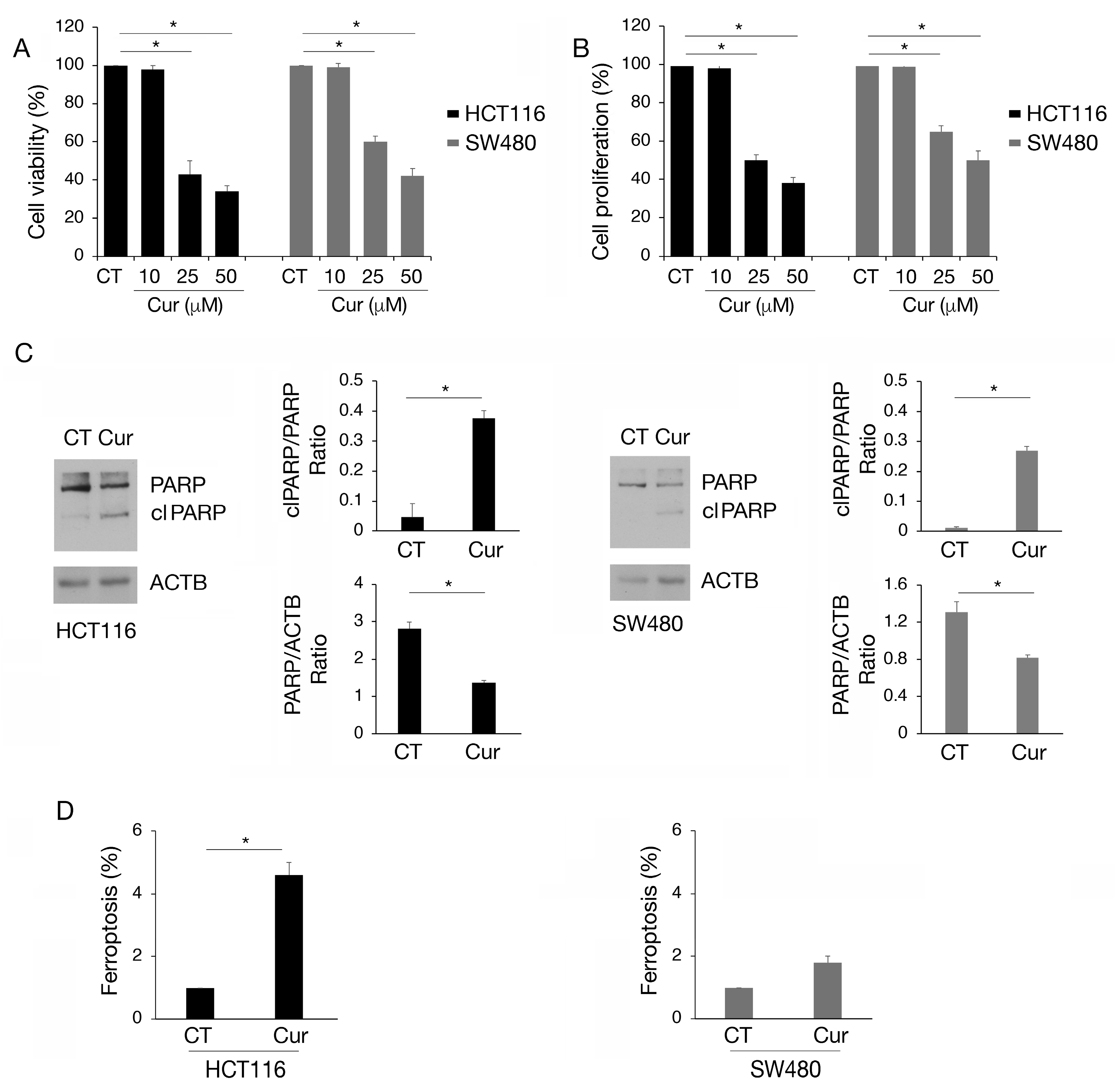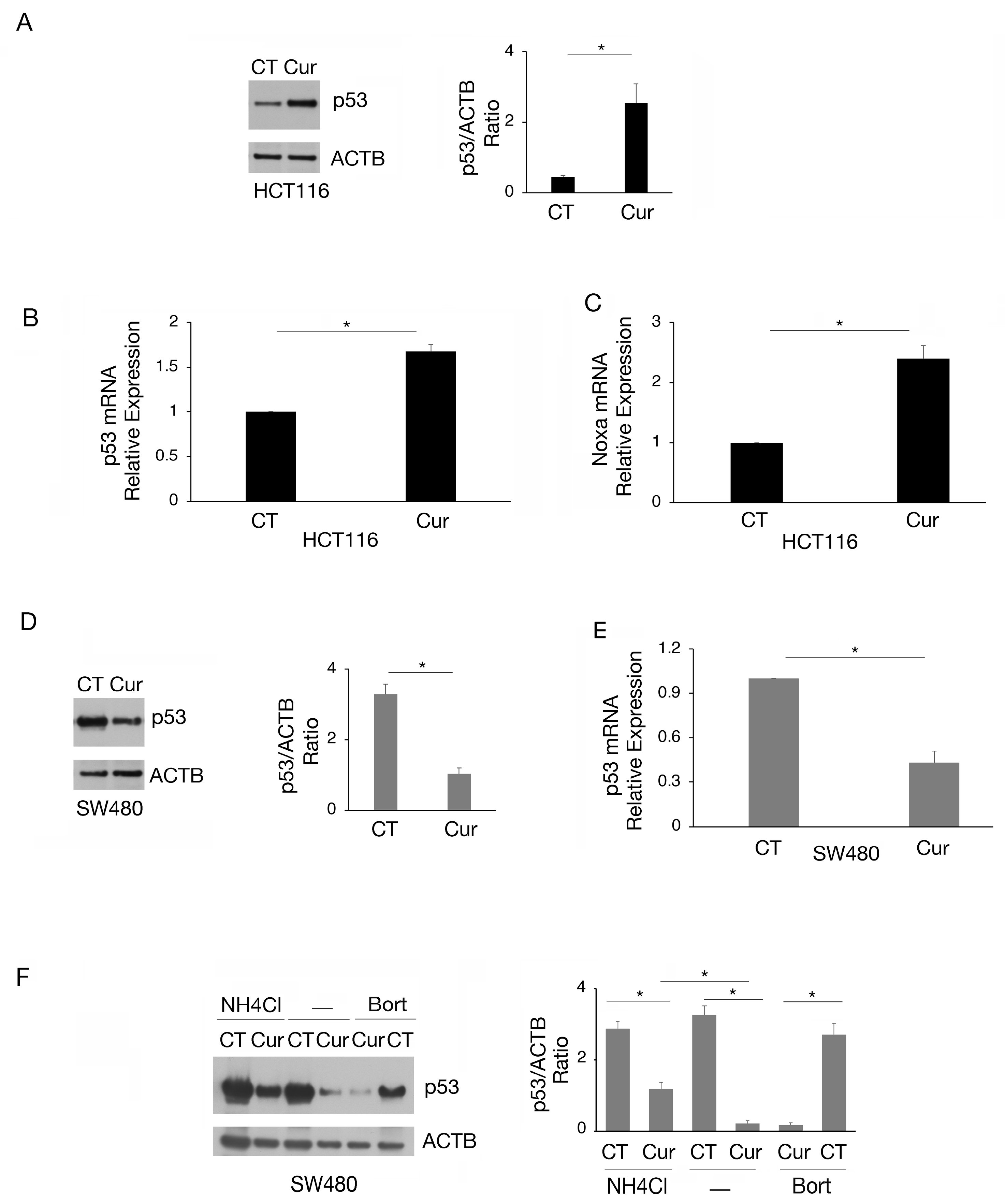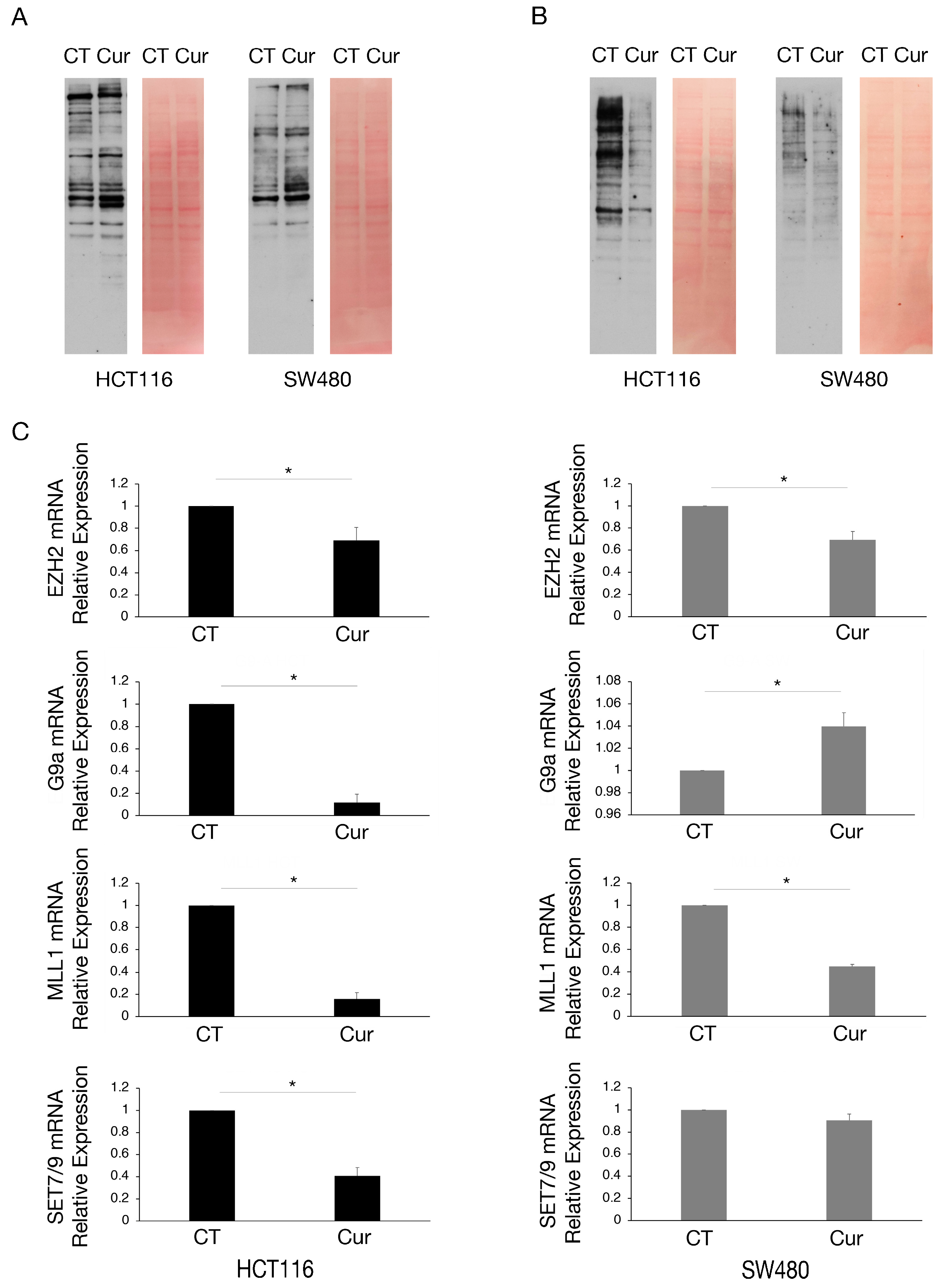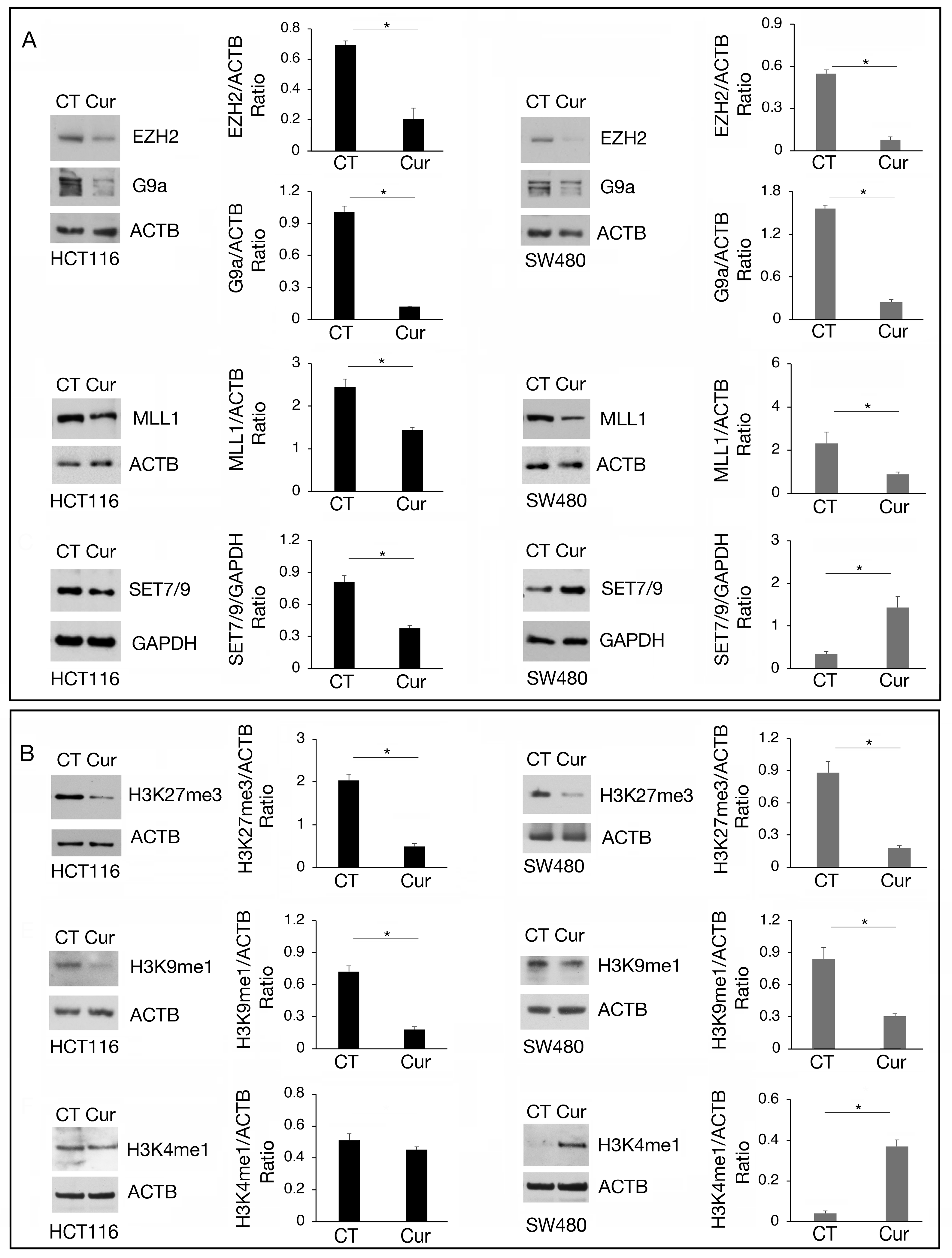Changes in Lysine Methylation Contribute to the Cytotoxicity of Curcumin in Colon Cancer Cells
Abstract
1. Introduction
2. Results
2.1. Curcumin Induces Colon Cancer Cell Apoptosis and Ferroptosis, Particularly in Cells Carrying wtp53
2.2. Curcumin Increases the Expression of wtp53 While Reducing That of mutp53 in Colon Cancer Cells
2.3. Curcumin Reduces Lysine Methylation and Changes the Expression of mRNA Encoding for Several Methyltransferases in Colon Cancer Cells
2.4. Methyltransferase Regulation by Curcumin Correlates with Histone Methylation
2.5. EZH2, G9a, MLL1, and to a Lesser Extent SET7/9 Contribute to the Cytotoxic Effect of Curcumin, Particularly in wtp53 HCT116 Cells
3. Discussion
4. Materials and Methods
4.1. Cell Cultures, Reagents, and Treatments
4.2. Cell Viability and Cell Proliferation Assays
4.3. Western Blotting
4.4. Antibodies
4.5. Densitometric Analysis
4.6. Quantitation of HNE Protein Adducts as a Marker of Ferroptosis
4.7. RNA Extraction, Reverse Transcription, and Quantitative Real-Time Polymerase Chain Reaction (qRT-PCR)
- Primers used were:
- NOXA1 Fw 5′–AATCATGGACTCCCCAAG–3′;
- NOXA1 Rev 5′–GAGAGAGGAGCCTGTTTG–3′;
- TP53 Fw 5′–GTGTGGAGTATTTGGATGAC–3′;
- TP53 Rev 5′–GTCAGAGCCAACCTCAG–3′;
- EZH2Fw 5′–CCATAAAATTCTGCTGTAGGG–3′;
- EZH2 Rev 5′–AAAAATAAGAGCAGCCTGAG–3′;
- G9-A Fw 5′–CAAGTCTGAAGTTGAAGCTC–3′;
- G9-A Rev 5′–ATCTTCCTCTTCTTCTTCCTC–3′;
- SET 7/9 FW 5′–CTGAATCTCTTATTTCCAGTGC–3′;
- SET 7/9 Rev 5′–AACCTCTTGGTGTGTAATTC–3′;
- MLL1 Fw 5′–AAAGACTTCTAAGGAGGCAG–3′;
- MLL1 Rev 5′–AACATATAGCAACCAATGCC–3′;
- ACTIN Fw 5′–TCATGAAGTGTGACGTGGACATC–3′;
- ACTIN Rev 5′–CAGGAGGAGCAATGATCTTGATCT–3′.
4.8. Statistical Analysis
Supplementary Materials
Author Contributions
Funding
Institutional Review Board Statement
Informed Consent Statement
Data Availability Statement
Conflicts of Interest
References
- Aggarwal, B.B.; Sung, B. Pharmacological basis for the role of curcumin in chronic diseases: An age-old spice with modern targets. Trends Pharmacol. Sci. 2009, 30, 85–94. [Google Scholar] [CrossRef]
- Walsby, E.; Pearce, L.; Burnett, A.K.; Fegan, C.; Pepper, C. The Hsp90 inhibitor NVP-AUY922-AG inhibits NF-kappaB signaling, overcomes microenvironmental cytoprotection and is highly synergistic with fludarabine in primary CLL cells. Oncotarget 2012, 3, 525–534. [Google Scholar] [CrossRef]
- Giordano, A.; Tommonaro, G. Curcumin and Cancer. Nutrients 2019, 11, 2376. [Google Scholar] [CrossRef] [PubMed]
- Zoi, V.; Galani, V.; Lianos, G.D.; Voulgaris, S.; Kyritsis, A.P.; Alexiou, G.A. The Role of Curcumin in Cancer Treatment. Biomedicines 2021, 9, 1086. [Google Scholar] [CrossRef]
- Arena, A.; Romeo, M.A.; Benedetti, R.; Masuelli, L.; Bei, R.; Gilardini Montani, M.S.; Cirone, M. New Insights into Curcumin- and Resveratrol-Mediated Anti-Cancer Effects. Pharmaceuticals 2021, 14, 1068. [Google Scholar] [CrossRef]
- Mackenzie, G.G.; Queisser, N.; Wolfson, M.L.; Fraga, C.G.; Adamo, A.M.; Oteiza, P.I. Curcumin induces cell-arrest and apoptosis in association with the inhibition of constitutively active NF-kappaB and STAT3 pathways in Hodgkin’s lymphoma cells. Int. J. Cancer 2008, 123, 56–65. [Google Scholar] [CrossRef]
- Shanmugam, M.K.; Arfuso, F.; Sng, J.C.; Bishayee, A.; Kumar, A.P.; Sethi, G. Chapter 5–Epigenetic Effects of Curcumin in Cancer Prevention. Epigenetics Cancer Prev. 2019, 8, 107–128. [Google Scholar] [CrossRef]
- Link, A.; Balaguer, F.; Shen, Y.; Lozano, J.J.; Leung, H.C.; Boland, C.R.; Goel, A. Curcumin modulates DNA methylation in colorectal cancer cells. PLoS ONE 2013, 8, e57709. [Google Scholar] [CrossRef]
- Hassan, F.U.; Rehman, M.S.; Khan, M.S.; Ali, M.A.; Javed, A.; Nawaz, A.; Yang, C. Curcumin as an Alternative Epigenetic Modulator: Mechanism of Action and Potential Effects. Front Genet. 2019, 10, 514. [Google Scholar] [CrossRef]
- Sawesi, S.; Malkaram, S.A.; Abd Elmageed, Z.Y.; Fandy, T.E. Modulation of the activity of histone lysine methyltransferases and demethylases by curcumin analog in leukaemia cells. J. Cell Mol. Med. 2022, 26, 5624–5633. [Google Scholar] [CrossRef]
- Miller, J.L.; Grant, P.A. The role of DNA methylation and histone modifications in transcriptional regulation in humans. Subcell Biochem. 2013, 61, 289–317. [Google Scholar] [CrossRef] [PubMed]
- Mantovani, F.; Collavin, L.; Del Sal, G. Mutant p53 as a guardian of the cancer cell. Cell Death Differ. 2019, 26, 199–212. [Google Scholar] [CrossRef]
- Benedetti, R.; Di Crosta, M.; D’Orazi, G.; Cirone, M. Post-Translational Modifications (PTMs) of mutp53 and Epigenetic Changes Induced by mutp53. Biology 2024, 13, 508. [Google Scholar] [CrossRef]
- Berger, S.L. Keeping p53 in check: A high-stakes balancing act. Cell 2010, 142, 17–19. [Google Scholar] [CrossRef]
- Chen, M.; Tan, A.H.; Li, J. Curcumin Represses Colorectal Cancer Cell Proliferation by Triggering Ferroptosis via PI3K/Akt/mTOR Signaling. Nutr. Cancer 2023, 75, 726–733. [Google Scholar] [CrossRef] [PubMed]
- Zhao, W.; Yan, Q.; Liu, L.; Hou, D.; Xiang, D.; Tang, D.; Li, L.; Shen, W.; Tao, W.; Cheng, H.; et al. Curcumol promotes ferroptosis of colon cancer by targeting the ubiquitination and degradation of GPX4. J. Tradit. Complement. Med. 2024. [Google Scholar] [CrossRef]
- Esteller, M. Cancer epigenomics: DNA methylomes and histone-modification maps. Nat. Rev. Genet. 2007, 8, 286–298. [Google Scholar] [CrossRef] [PubMed]
- Lao, V.V.; Grady, W.M. Epigenetics and colorectal cancer. Nat. Rev. Gastroenterol. Hepatol. 2011, 8, 686–700. [Google Scholar] [CrossRef]
- Wang, N.; Ma, T.; Yu, B. Targeting epigenetic regulators to overcome drug resistance in cancers. Signal Transduct. Target Ther. 2023, 8, 69. [Google Scholar] [CrossRef] [PubMed]
- Ming, T.; Tao, Q.; Tang, S.; Zhao, H.; Yang, H.; Liu, M.; Ren, S.; Xu, H. Curcumin: An epigenetic regulator and its application in cancer. Biomed. Pharmacother. 2022, 156, 113956. [Google Scholar] [CrossRef] [PubMed]
- Liu, Y.; Yang, Q. The roles of EZH2 in cancer and its inhibitors. Med. Oncol. 2023, 40, 167. [Google Scholar] [CrossRef]
- Ansari, K.I.; Kasiri, S.; Mandal, S.S. Histone methylase MLL1 has critical roles in tumor growth and angiogenesis and its knockdown suppresses tumor growth in vivo. Oncogene 2013, 32, 3359–3370. [Google Scholar] [CrossRef]
- Ni, Y.; Shi, M.; Liu, L.; Lin, D.; Zeng, H.; Ong, C.; Wang, Y. G9a in Cancer: Mechanisms, Therapeutic Advancements, and Clinical Implications. Cancers 2024, 16, 2175. [Google Scholar] [CrossRef]
- Huang, Y.; Liu, N.; Liu, J.; Liu, Y.; Zhang, C.; Long, S.; Luo, G.; Zhang, L.; Zhang, Y. Mutant p53 drives cancer chemotherapy resistance due to loss of function on activating transcription of PUMA. Cell Cycle 2019, 18, 3442–3455. [Google Scholar] [CrossRef]
- Zhao, M.; Wang, T.; Gleber-Netto, F.O.; Chen, Z.; McGrail, D.J.; Gomez, J.A.; Ju, W.; Gadhikar, M.A.; Ma, W.; Shen, L.; et al. Mutant p53 gains oncogenic functions through a chromosomal instability-induced cytosolic DNA response. Nat. Commun. 2024, 15, 180. [Google Scholar] [CrossRef] [PubMed]
- Hong, T.; Lei, G.; Chen, X.; Li, H.; Zhang, X.; Wu, N.; Zhao, Y.; Zhang, Y.; Wang, J. PARP inhibition promotes ferroptosis via repressing SLC7A11 and synergizes with ferroptosis inducers in BRCA-proficient ovarian cancer. Redox. Biol. 2021, 42, 101928. [Google Scholar] [CrossRef]
- Lopresti, A.L. The Problem of Curcumin and Its Bioavailability: Could Its Gastrointestinal Influence Contribute to Its Overall Health-Enhancing Effects? Adv. Nutr. 2018, 9, 41–50. [Google Scholar] [CrossRef]
- Garufi, A.; Ricci, A.; Trisciuoglio, D.; Iorio, E.; Carpinelli, G.; Pistritto, G.; Cirone, M.; D’Orazi, G. Glucose restriction induces cell death in parental but not in homeodomain-interacting protein kinase 2-depleted RKO colon cancer cells: Molecular mechanisms and implications for tumor therapy. Cell Death Dis. 2013, 4, e639. [Google Scholar] [CrossRef]





Disclaimer/Publisher’s Note: The statements, opinions and data contained in all publications are solely those of the individual author(s) and contributor(s) and not of MDPI and/or the editor(s). MDPI and/or the editor(s) disclaim responsibility for any injury to people or property resulting from any ideas, methods, instructions or products referred to in the content. |
© 2025 by the authors. Licensee MDPI, Basel, Switzerland. This article is an open access article distributed under the terms and conditions of the Creative Commons Attribution (CC BY) license (https://creativecommons.org/licenses/by/4.0/).
Share and Cite
Santarelli, R.; Currà, P.; Di Crosta, M.; Gonnella, R.; Gilardini Montani, M.S.; Cirone, M. Changes in Lysine Methylation Contribute to the Cytotoxicity of Curcumin in Colon Cancer Cells. Molecules 2025, 30, 335. https://doi.org/10.3390/molecules30020335
Santarelli R, Currà P, Di Crosta M, Gonnella R, Gilardini Montani MS, Cirone M. Changes in Lysine Methylation Contribute to the Cytotoxicity of Curcumin in Colon Cancer Cells. Molecules. 2025; 30(2):335. https://doi.org/10.3390/molecules30020335
Chicago/Turabian StyleSantarelli, Roberta, Paola Currà, Michele Di Crosta, Roberta Gonnella, Maria Saveria Gilardini Montani, and Mara Cirone. 2025. "Changes in Lysine Methylation Contribute to the Cytotoxicity of Curcumin in Colon Cancer Cells" Molecules 30, no. 2: 335. https://doi.org/10.3390/molecules30020335
APA StyleSantarelli, R., Currà, P., Di Crosta, M., Gonnella, R., Gilardini Montani, M. S., & Cirone, M. (2025). Changes in Lysine Methylation Contribute to the Cytotoxicity of Curcumin in Colon Cancer Cells. Molecules, 30(2), 335. https://doi.org/10.3390/molecules30020335







